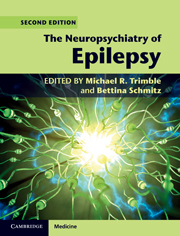39 results
Forced Normalisation and Its Relevance for Neuropsychiatry
-
- Journal:
- European Psychiatry / Volume 11 / Issue S4 / 1996
- Published online by Cambridge University Press:
- 16 April 2020, p. 208s
-
- Article
-
- You have access
- Export citation
Chapter 2 - Psychogenic Nonepileptic Seizures
- from Section 1 - Recognition, Diagnosis, and Impact of Nonepileptic Seizures
-
-
- Book:
- Gates and Rowan's Nonepileptic Seizures
- Published online:
- 18 May 2018
- Print publication:
- 03 May 2018, pp 19-30
-
- Chapter
- Export citation
Social and psychological consequences of not crying: possible associations with psychopathology and therapeutic relevance
-
- Journal:
- CNS Spectrums / Volume 23 / Issue 6 / December 2018
- Published online by Cambridge University Press:
- 23 August 2017, pp. 414-422
-
- Article
- Export citation
Contributors
-
-
- Book:
- Traumatic Brain and Spinal Cord Injury
- Published online:
- 05 August 2012
- Print publication:
- 19 July 2012, pp ix-xii
-
- Chapter
- Export citation

The Neuropsychiatry of Epilepsy
-
- Published online:
- 07 October 2011
- Print publication:
- 09 June 2011
Contributors
-
-
- Book:
- The Neuropsychiatry of Epilepsy
- Published online:
- 07 October 2011
- Print publication:
- 09 June 2011, pp vi-viii
-
- Chapter
- Export citation
Chapter 14 - Antiepileptic drugs and suicide
-
-
- Book:
- The Neuropsychiatry of Epilepsy
- Published online:
- 07 October 2011
- Print publication:
- 09 June 2011, pp 143-152
-
- Chapter
- Export citation
Chapter 1 - Introduction
-
-
- Book:
- The Neuropsychiatry of Epilepsy
- Published online:
- 07 October 2011
- Print publication:
- 09 June 2011, pp 1-2
-
- Chapter
- Export citation
The Neuropsychiatry of Epilepsy - Title page
-
-
- Book:
- The Neuropsychiatry of Epilepsy
- Published online:
- 07 October 2011
- Print publication:
- 09 June 2011, pp iii-iii
-
- Chapter
- Export citation
The Neuropsychiatry of Epilepsy - Half title page
-
- Book:
- The Neuropsychiatry of Epilepsy
- Published online:
- 07 October 2011
- Print publication:
- 09 June 2011, pp i-ii
-
- Chapter
- Export citation
Contents
-
- Book:
- The Neuropsychiatry of Epilepsy
- Published online:
- 07 October 2011
- Print publication:
- 09 June 2011, pp v-v
-
- Chapter
- Export citation
Index
-
- Book:
- The Neuropsychiatry of Epilepsy
- Published online:
- 07 October 2011
- Print publication:
- 09 June 2011, pp 221-225
-
- Chapter
- Export citation
Copyright page
-
- Book:
- The Neuropsychiatry of Epilepsy
- Published online:
- 07 October 2011
- Print publication:
- 09 June 2011, pp iv-iv
-
- Chapter
- Export citation
19 - Antiepileptic drug interactions in patients requiring psychiatric drug treatment
- from Part IV - Drug interactions in specific patient populations and special conditions
-
-
- Book:
- Antiepileptic Drugs
- Published online:
- 07 September 2009
- Print publication:
- 26 May 2005, pp 350-368
-
- Chapter
- Export citation
The Frontal Lobes and Neuropsychiatric Illness Edited by Stephen P. Salloway, Paul E. Malloy & James D. Duffy Washington, DC: American Psychiatric Press. 2001. 274 pp. £49.95 (hb). ISBN 0 88048 800 X
-
- Journal:
- The British Journal of Psychiatry / Volume 181 / Issue 3 / September 2002
- Published online by Cambridge University Press:
- 02 January 2018, pp. 265-266
- Print publication:
- September 2002
-
- Article
-
- You have access
- HTML
- Export citation
Handbook of Neurological Speech and Language Disorders. Edited by Howard Kirschner. New York: Marcel Dekker. 1994. 532 pp. $175.00 (hb).
-
- Journal:
- The British Journal of Psychiatry / Volume 167 / Issue 5 / November 1995
- Published online by Cambridge University Press:
- 02 January 2018, p. 701
- Print publication:
- November 1995
-
- Article
- Export citation
Brain Perfusion Abnormalities in Gilles de la Tourette's Syndrome
-
- Journal:
- The British Journal of Psychiatry / Volume 167 / Issue 2 / August 1995
- Published online by Cambridge University Press:
- 02 January 2018, pp. 249-254
- Print publication:
- August 1995
-
- Article
- Export citation
The Neurological Boundaries of Reality. Edited by E. M. R. Critchley London: Farrand Press. 1994. 448 pp. £29.50 (hb).
-
- Journal:
- The British Journal of Psychiatry / Volume 166 / Issue 5 / May 1995
- Published online by Cambridge University Press:
- 02 January 2018, pp. 689-690
- Print publication:
- May 1995
-
- Article
- Export citation
Pseudo-Epileptic Seizures. Edited By L. Gram, S. I. Johannessen, P. O. Osterman and M. Sillanpää. 1993. Petersfield: Wrightson Biomedical Publishing. 165 pp. £27.00.
-
- Journal:
- The British Journal of Psychiatry / Volume 164 / Issue 2 / February 1994
- Published online by Cambridge University Press:
- 02 January 2018, pp. 282-283
- Print publication:
- February 1994
-
- Article
- Export citation
Thalamo-frontal psychosis
-
- Journal:
- The British Journal of Psychiatry / Volume 164 / Issue 1 / January 1994
- Published online by Cambridge University Press:
- 02 January 2018, pp. 124-125
- Print publication:
- January 1994
-
- Article
-
- You have access
- Export citation



